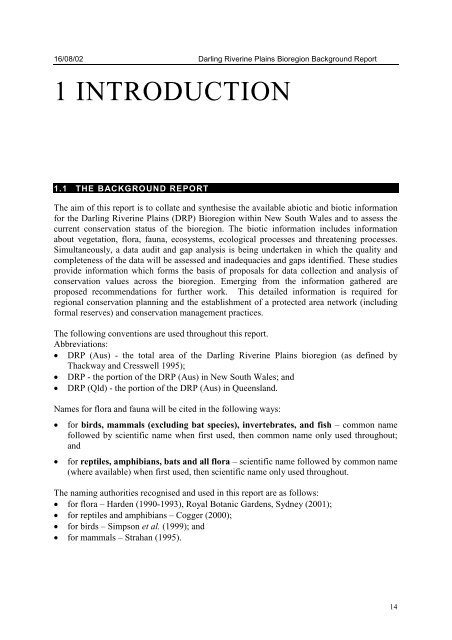DARLING RIVERINE PLAINS BIOREGION Background Report
DARLING RIVERINE PLAINS BIOREGION Background Report
DARLING RIVERINE PLAINS BIOREGION Background Report
You also want an ePaper? Increase the reach of your titles
YUMPU automatically turns print PDFs into web optimized ePapers that Google loves.
16/08/02 Darling Riverine Plains Bioregion <strong>Background</strong> <strong>Report</strong><br />
1 INTRODUCTION<br />
1.1 THE BACKGROUND REPORT<br />
The aim of this report is to collate and synthesise the available abiotic and biotic information<br />
for the Darling Riverine Plains (DRP) Bioregion within New South Wales and to assess the<br />
current conservation status of the bioregion. The biotic information includes information<br />
about vegetation, flora, fauna, ecosystems, ecological processes and threatening processes.<br />
Simultaneously, a data audit and gap analysis is being undertaken in which the quality and<br />
completeness of the data will be assessed and inadequacies and gaps identified. These studies<br />
provide information which forms the basis of proposals for data collection and analysis of<br />
conservation values across the bioregion. Emerging from the information gathered are<br />
proposed recommendations for further work. This detailed information is required for<br />
regional conservation planning and the establishment of a protected area network (including<br />
formal reserves) and conservation management practices.<br />
The following conventions are used throughout this report.<br />
Abbreviations:<br />
DRP (Aus) - the total area of the Darling Riverine Plains bioregion (as defined by<br />
Thackway and Cresswell 1995);<br />
DRP - the portion of the DRP (Aus) in New South Wales; and<br />
DRP (Qld) - the portion of the DRP (Aus) in Queensland.<br />
Names for flora and fauna will be cited in the following ways:<br />
for birds, mammals (excluding bat species), invertebrates, and fish – common name<br />
followed by scientific name when first used, then common name only used throughout;<br />
and<br />
for reptiles, amphibians, bats and all flora – scientific name followed by common name<br />
(where available) when first used, then scientific name only used throughout.<br />
The naming authorities recognised and used in this report are as follows:<br />
for flora – Harden (1990-1993), Royal Botanic Gardens, Sydney (2001);<br />
for reptiles and amphibians – Cogger (2000);<br />
for birds – Simpson et al. (1999); and<br />
for mammals – Strahan (1995).<br />
14

















